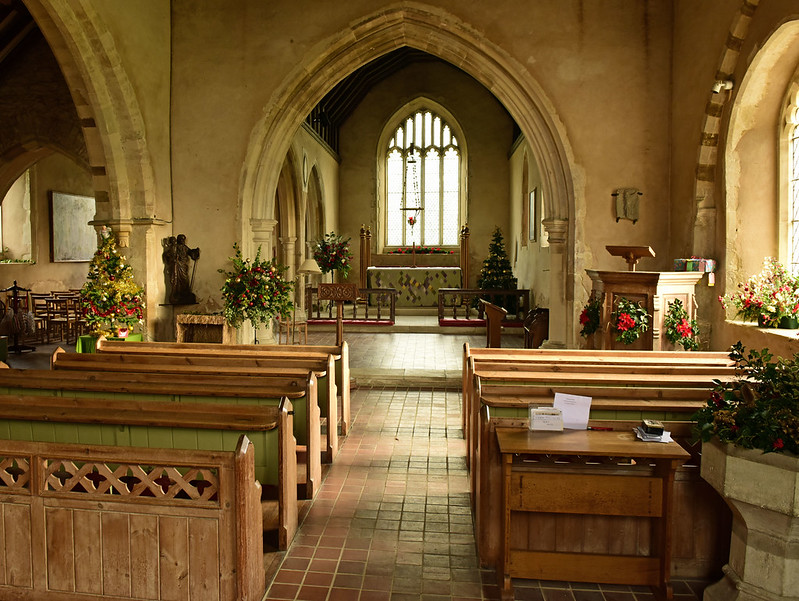- map
- how you can help
- FAQ's
- contact
- copyright
-
ahnentafel and citation # display:| |

| Snapshot: | member of Parliament; sheriff of Sussex and Surry refugee of the Hundred Years' War; later organized a navy, probably for the same war |
| Parents: | unknown |
| Born: | unknown |
| Died: | between 14 November and 8 December 1415 presumably Iden, East Sussex, England |
| Buried: | in All Saints Church, Iden, East Sussex, England church's coordinates: N50.9813 E0.7274 |
On 20 September 1364
In 1374 a man named John Glesham was in debt to
In the midst of the Hundred Years War, on 29 June 1377 French soldiers invaded East Sussex, destroyed Rye, then proceeded to raid other nearby towns over the following months. Historian Jonathan Sumption describes the attack on Rye:
On 29 June 1377 the French and Castilian admirals landed at dawn beneath the ruins of Winchelsea. The invaders beached their ships and made their way in the early light along the marshy estuary of the Rother to fall on Rye. Rye was vulnerable, as those who remembered the French raid of 1339 knew. It was a small river port which then stood about a mile inland on a low cliff above the river estuary, gnawed by the tides on its eastern side. The municipality had levied money to build a circuit of walls but the defences were still incomplete when the French returned. The inhabitants at first resisted with ferocity. But after the first assault, in which many of them were killed, the rest fled into the country around or surrendered to the invaders. The French Admiral, Jean de Vienne, occupied the town. He sent most of his army back to the ships to continue their cruise west towards Hastings. He himself planned to dig his force in at Rye and use it as a base for wasting the surrounding, region.4
Not surprisingly, then, Englishmen in the area were fearful of French invasion for some years thereafter. On 14 January 1385,
He wasn't gone for long, though, since a record dated 12 January 1387 notes that he was the mayor of Rye, a baron of the Cinque Ports, and was also preparing a navy for an expedition.
A 1388 court record mentions his wife 1050815Agnes, and is the earliest record I've found that mentions her.
Sometime between 25 December and 2 February 1389/90,
Beginning in the late 1390's,
| Date | Town(s) | Bought, or Sold? | Description of Land | Source |
|---|---|---|---|---|
| 1397 | Iden, Playden, Rye, and Beckley | Bought | a messuage, 152 acres of land, 10 acres of wood, 40 acres of heath, 310 acres of marsh | 11 |
| 9 January 1399 | Rye | Sold | 4 acres | 12 |
| 1401 | Iden | Bought | a messuage, 162 acres of land, 10 acres of wood, 50 acres of heath, 310 acres of marsh | 13 |
| 7 June 1402 | Rye | Sold | 2 acres | 14 |
| February 1405 | "Ebbene Stone + Wyghtrysham" (I can't identify these towns.) |
Bought | a messuage, 180 acres land, 10 acres meadow, 10 acres wood | 15 |
| 3 April 1410 | Rye | Sold | a parcel of land in Rye outside the North Gate | 16 |
| 1412 | Rye | N/A | 17 |

A record dated 12 Febuary 1415 shows that someone was in debt to
As you can see,

1: Calendar of the Patent Rolls Preserved in the Public Record Office, Edward III, Volume XIII (1364-1367), page 16.
2: ibid., page 17.
3: Calendar of the Patent Rolls Preserved in the Public Record Office, Edward III, Volume XVI (1374-1377), 57.
4: Jonathan Sumption, The Hundred Years War, Volume 3: Divided Houses (University of Pennsylvania Press, 2009), page 281.
5: Calendar of the Patent Rolls Preserved in the Public Record Office, Richard II, Volume II (1381-1385), page 519.
6: Calendar of the Close Rolls Preserved in the Public Record Office, Richard II, Volume III (1385-1389), page 290.
7: John Stokes, "The Barons of New Romney in Parliament," Archaeologia Cantiana, Volume 29, pages 46-47.
8: Fifth Report of the Royal Commission on Historical Manuscripts: Part I (London, 1876), page 512, abstract of a deed from Robert Bocher to John Macope and his wife Alice. The abstract simply provides the year (15 Richard II), but the record is actually dated 18 July 1391.
9: L. F. Salzmann, An Abstract of Feet of Fines For the County of Sussex, From 1 Edward II to 24 Henry VII [Volume 3] (Sussex Record Society, 1916), page 196, entry #2588. The entry is in the section for the year 12 Richard II [= 1388] and reads, "John Salerne of Rye and Agnes his wife (by Robert Oxebrigg) v. Thomas Cokefeld and Laurencia his wife; 7 marks rent in Idenne; to John and Agnes. (File 77. No. 7.)."
10: East Sussex and Brighton and Hove Record Office reference RYE/47/1/4. I have not seen the original record and merely used the abstract at the link provided.
11: L. F. Salzmann, An Abstract of Feet of Fines For the County of Sussex, From 1 Edward II to 24 Henry VII [Volume 3] (Sussex Record Society, 1916), page 208, entry #2680. The entry is in the section for the year 21 Richard II [= 1397] and reads, "Robert Oxenbregge and William Marchaunt v. John Salerne and Agnes his wife; a messuage, 152 acres of land, 10 acres of wood, 40 acres of heath, 310 acres of marsh, £4 13s. 4d. rent in Idenne, Playdenne, Rye and Bekkele; to John and Agnes for life, remainder to William son of Roger Asshburnham and Ann his wife, daughter to the said John and Agnes, and heirs of their bodies, contingent remainder to right heirs of John. (File 79. No. 11.)."
12: East Sussex and Brighton and Hove Record Office reference number RYE/136/152. I have not seen the original record and merely used the abstract at the link provided.
13: L. F. Salzmann, An Abstract of Feet of Fines For the County of Sussex, From 1 Edward II to 24 Henry VII [Volume 3] (Sussex Record Society, 1916), page 212, entry #2680. The entry is in the section for the year 2 Henry IV [= 1401] and reads, "William Marchaunt and Richard Huntyngdon v. John Salerne and Agnes his wife; a messuage, 162 acres of land, 10 acres of wood, 50 acres of heath, 310 acres of marsh, 77s. rent in Idenne; to John and Agnes for life, remainder to Richard Brenchesle and Ann his wife for life, remainder to right heirs of John. (File 80. No. 18.)."
14: East Sussex and Brighton and Hove Record Office reference number RYE/122/2. I have not seen the original record and merely used the abstract at the link provided.
15: UK National Archives reference CP 25/1/112/263/248. I obtained an image of this record from: Anglo-American Legal Tradition, O'Quinn Law Library, University of Houston; <http://aalt.law.uh.edu/AALT4/CP25(1)/CP25_1_112/IMG_0289.htm>, accessed 12 May 2022. An abstract of this record at <https://www.kentarchaeology.ac/Records/KRNS5-2.pdf> (Search "248") reads as follows:
| (248) Westminster: Morrow of the Purification 6 Henry IV | |
| Q. Richard Huntyndone | |
| D. John Salerne of Idenne and wife Agnes | |
| A messuage, 180 acres land, 10 acres meadow, 10 acres wood, 3s ½d rent and rent of 4 hens in Ebbene, Stone and Wyghtrysham. To hold to John and Agnes for their lives. Remainder to (1) William Cheyne and wife Eleanor for their lives (2) the heirs of John. |
16: East Sussex and Brighton and Hove Record Office (ESBHRO) reference RYE/136/163. I have not seen the original record and merely used the abstract at the link provided.
17: Inquisitions and Assessments Relating to Feudal Aids [...]: 1284-1431, Volume 6 (London, 1920), page 527.
18: David Burns, The Sheriffs of Surrey (Phillimore, 1992), page 55.
19: E. F. Jacob, ed., and H. C. Johnson, The Register of Henry Chichele, Archbishop of Canterbury: 1414-1443, Volume II (University Press, Oxford, 1937), page 70. This a transcription of the will of Iohannis Salerne, which is in Latin. I have been unable to find the original record that Jacob and Johnson transcribed.
20: UK National Archives reference C 1/4/78. I obtained an image of this record from: Anglo-American Legal Tradition, O'Quinn Law Library, University of Houston; <http://aalt.law.uh.edu/AALT4/ChP/C1no4/IMG_0091.htm>, accessed 12 May 2022.
21: UK National Archives reference C 131/59/8
22: Leonard Bentley, "All Saints Church, Iden" (photograph taken 30 December 2015). Flickr, <https://www.flickr.com/photos/31363949@N02/24038021106/, accessed 31 May 2022. Mr. Bentley has made this image available under a Creative Commons BY-SA 2.0 license.